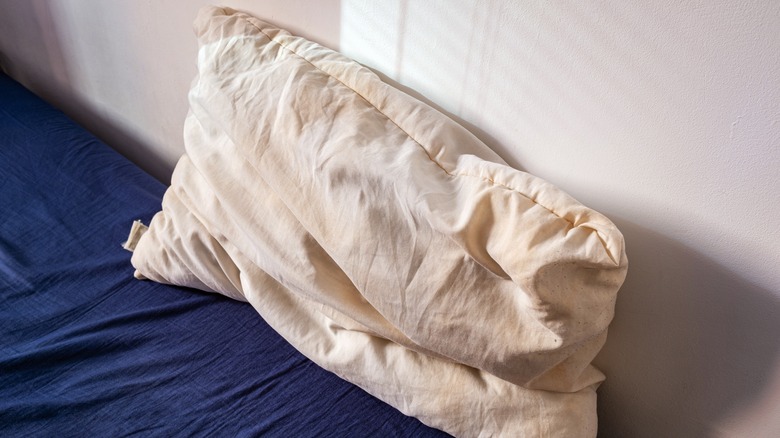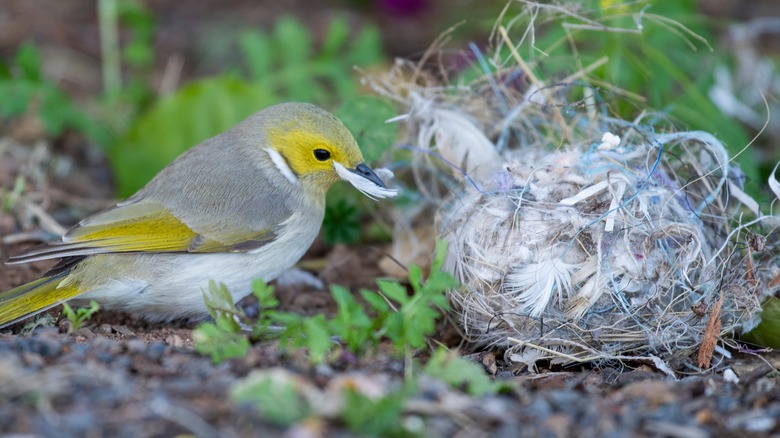How You Should Repurpose Dirty Old Pillows In The Garden Instead Of Tossing Them
It can be hard to say goodbye to your favorite pillow. But after a few years, even the best pillows can end up flatter than a pancake. Flat or not, the Asthma and Allergy Foundation of America recommends replacing pillows every five years because they can harbor mold, dust mites, and other irritants that you don't want to breathe in while you sleep.
Just because you're due for an upgrade in your bedroom doesn't mean you have to toss your faithful old pillow in the trash, though. They may well be past their prime as pillows or too dirty to upcycle into cute home décor around the house. But with a little creativity, there are tons of ways to repurpose old pillows in your home and garden to give them new life and purpose.
From providing fresh nesting material for your favorite songbirds to upcycling pillow covers into totes or plant ties, you might be surprised at how many ways you can reuse those old pillows around your garden. Every single one of these ideas beats tossing it in the trash and letting it end up in a landfill. Just check the tag first to see what your stuffing and cover are made of before deciding how to repurpose your old pillow. If the tag is no longer legible, it's probably safer to assume it's synthetic material. Don't worry; there are still plenty of uses for an old pillow, even if it's not made of natural fibers.
How to repurpose your old pillow filling
If your pillows are stuffed with feathers, cotton or another natural material, one of the best things you can do is add it to your compost pile. As long as the stuffing is made from 100% natural fiber (not a synthetic blend), it will break down along with everything else to become a nutrient-rich compost to feed your garden.
Another option for feather or cotton stuffing is to leave a pile it of it in your backyard for birds to use as nesting material. This is a great way to attract birds to your garden. Just put out a few different stashes of feathers or cotton fluff along with any bark chips or twigs you might have in your yard. Multiple small piles ensure your bird visitors don't have to fight each other for nesting material. You can simply leave piles on the ground, or, for a tidier look, stuff it into old berry baskets or unused hanging planters.
If your old pillows are synthetic, the filling won't work as compost or nesting material, but you can still get some use out of it. Stuff synthetic filling into a waterproof case to make a DIY garden kneeler for extra comfort while weeding or working in your garden. If the cushions on your patio furniture are starting to slouch, you can also use the stuffing from old pillows to give new life to your outdoor cushions.
Creative ways to upcycle old pillow covers
While there are a surprising number of ways to repurpose old pillow stuffing, there are even more ways to repurpose the fabric cover that stuffing came in. The easiest option is to simply cut it open on one side and use it as a tote for gathering produce from your vegetable garden, weeds that are destined for a compost bin or anything else you might need to carry in your garden. Another easy idea is to use them as plant covers to protect your plants when you're expecting a frost.
If you're handy around a sewing machine or feeling extra creative, you can use the fabric to make anything from an apron for your garden tools to budget-friendly fabric grow bags. If all else fails, you can always cut the fabric up into rags to use for cleaning or into thinner strips that you can use as plant ties to support unstable plants like tomatoes. Covers that are made from 100% cotton or another natural fiber can also be shredded and added to your compost along with the filling. Alternatively, cut the seams and lay it down in your garden bed to use as a biodegradable weed barrier.


